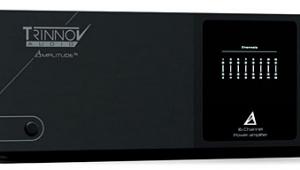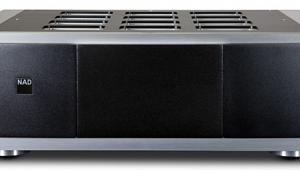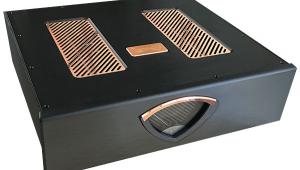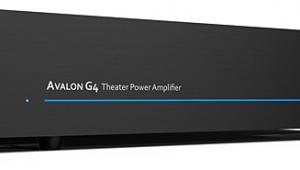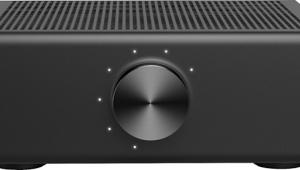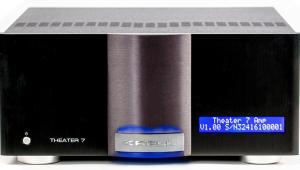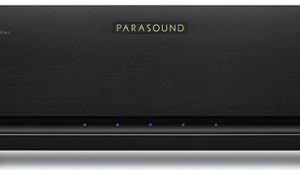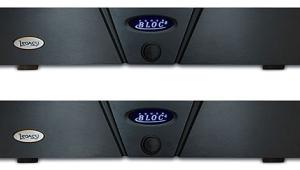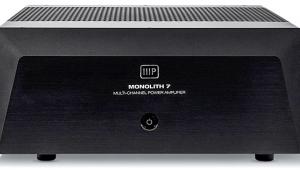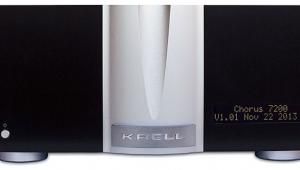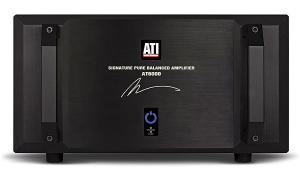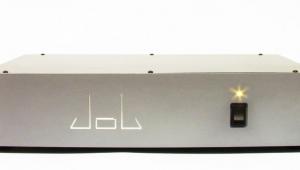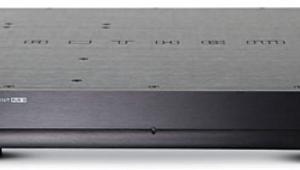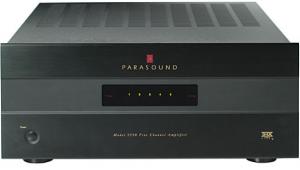Test Report: Steinway Lyngdorf S-Series Audio System Page 3
Extended Test Bench
Frequency response
- satellite (Global mode) 186 Hz to 20 kHz ±6.7 dB
- satellite (Focus mode) 191 Hz to 20 kHz ±6.7 dB
- satellite (Bypass mode) 215 Hz to 20 kHz ±7.8 dB
- subwoofer 23 to 92 Hz ±3 dB
Bass output, subwoofer (CEA-2010 standard)
• Ultra-low bass (20-31.5 Hz) average: | 107.2 dB |
20 Hz | 104.4 dB |
25 Hz | 105.7 dB |
31.5 Hz | 110.4 dB |
• Low bass (40-63 Hz) average: | 120.6 dB |
40 Hz | 119.8 dB L |
50 Hz | 121.1 dB L |
63 Hz | 120.9 dB L |
Bass limits
• satellite 88.9 dB at 40 Hz
Because the S-15 satellite and LS subwoofer are designed as part of a system including electronics and DSP, and not intended to be used on their own, I had to depart in some ways from my usual measurement methods. I measured both driven by the Steinway Lyngdorf electronics, so the DSP correction was active. I also ran several in-room measurements of the system in its different modes.
For the S-15, the frequency response curve shown here represents the average of results at 0°, ±10°, ±20°, and ±30°, all performed with a Clio FW audio analyzer. Because the S-15 is designed primarily for wall-mounting, I mounted the speaker on an ersatz wall, a 2-by-4-foot sheet of plywood attached to a stand and mounted on my measurement turntable. The microphone was placed on-axis with the tweeter (the position where I got the flattest response) at a distance of 2 meters. The measurements were taken using quasi-anechoic technique (with Clio in MLS mode) above 250 Hz and close-miking of the S-15’s woofer (with Clio in log chirp mode) below 250 Hz. For the LS subwoofer, I performed a ground plane measurement to get the total bass output of the two woofers. All results were imported into a LinearX LMS analyzer for post-processing. The S-15’s measurement was normalized to 0 dB at 1 kHz, and the LS’s so that its peak output was +3 dB. All curves were smoothed to 1/12th octave.
Even though I wasn’t able to recalibrate RoomPerfect for the measurement environment, Focus and Global still gave me smoother measured results from the S-15 than the Bypass setting did; apparently the compensation for wall-mounting that RoomPerfect applied in my listening room also yielded benefits when I mounted the S-15 on my ersatz measuring wall. The S-15’s measurements are obviously marred by that dip at 530 Hz, which is an unavoidable cancellation effect caused by the wall-mounting. (Because it’s a cancellation effect, or “suckout,” it can’t be corrected through equalization; any additional energy pumped into that band would simply be canceled.) Without that cancellation dip, the measurements are better: ±6.0 dB in Bypass, ±4.6 dB in Global, and ±4.8 dB in Focus.
Another performance parameter that DSP can’t do much to correct is off-axis response, and it’s here that the S-15 really excels, showing almost no change in response at angles out to ±30°. At ±45°, the midrange response is reduced by max -5.9 dB between 800 Hz and 2.5 kHz (that’s the dispersion of the woofer narrowing as frequency rises), but overall response at this angle is actually flatter than it is on-axis. Although the treble response gets a little ragged at angles of ±30° or greater, it remains essentially flat relative to the midrange and bass, which is unusual — typically, treble response is greatly reduced at ±45° and ±60°, but not so in the case of the S-15. That’s the rear tweeter reflector working, I assume.
You can tell from the frequency response chart that the S-15’s bass extension is limited, but the robust woofer still delivers useful output all the way down at 40 Hz. However, the system’s 300-Hz crossover point doesn’t capitalize on the little woofer’s muscle.
Although the S-15’s sensitivity and impedance are irrelevant because the speaker is not available on its own, I measured them anyway out of curiosity. Impedance runs below 5 ohms between 210 Hz and 570 Hz and again above 4.5 kHz, and hits a low of 2.7 ohms at 11 kHz with a phase angle of -19°. Sensitivity (average of quasi-anechoic measurement from 300 Hz to 10 kHz at 1 meter at 0° with a 2.83-volt RMS signal) is a little above average at 90.3 dB.
The LS Boundary Woofer’s frequency response when driven by the Steinway Lyngdorf processor and amplifiers shows good low-frequency extension, but an unusual “shelving” effect from about 100 to 235 Hz; I assume this curve is chosen in order to deliver substantial bass output while also delivering enough high-frequency response to make the 300-Hz crossover.
Speaking of the high crossover point (which in most good home theater systems would be set at 80 Hz), Lyngdorf provided an interesting technical explanation of why it didn’t result in bloated voices as it normally would. He said the sound quality resulted from excellent impulse response — the woofers’ ability to produce high output immediately yet also stop producing output the moment the signal ends. “If you don’t have good impulse response, you can easily hear woofer placement because the woofer keeps playing after the music stops,” he said.
He noted that the corner placement of the woofers is essential for good impulse response. “Corner placement delivers a unified wavefront coming from the corner, rather than the more chaotic result you’d get with the woofer placed elsewhere,” he said. “Think of when you make a splash in the corner of a pool. The waves go out uniformly from the corner.”
I did once hear the bloated voices I feared, when I streamed Battlestar Galactica episodes (the Edward James Olmos version, not the Lorne Greene one) from Netflix, processed through Dolby Pro Logic II in the P1. Given that the flaw never occurred with 5.1 or stereo material, I suspected it might be due to a software bug in the PLII implementation. After checking on a different S-Series system, Lyngdorf confirmed what I heard in PLII and stated that “it will be very simple to fix the issue.”
CEA-2010 output measurements for the subwoofer were taken at 2 meters and then scaled up +6 dB per CEA-2010 requirements so that they are equivalent to 1-meter results. An L appears next to those measurements in which maximum output was dictated by the amplifier’s internal limiter. I measured a single subwoofer; figure on roughly 6 dB of additional output (depending on room acoustics) when a second subwoofer is added. At press time, the CEA had instituted changes to the CEA-2010 standard but had yet to publish them; however, I do know that the new standard requires averaging in pascals rather than in decibels, so that’s the procedure I followed here. Averaged using pascals (the new method) and decibels (the old method), the subwoofer’s output is: low bass 120.6 dB/120.6 dB, ultra-low bass 107.2 dB/106.8 dB. That’s pretty kick-ass for a modestly sized subwoofer like the LS.
My in-room spectrum analysis of the system (shown in the accompanying chart) indicated that RoomPerfect’s compensation, at least from a magnitude standpoint, is conservative. (These measurements were taken with the mike in my listening chair positioned at ear height, using pink noise and the Clio FW in FFT mode. Results are normalized at 1 kHz.) You can see the results in Bypass (blue trace), Global (purple trace), and Focus (green trace) modes. The biggest difference is in the bass correction, where Focus was aggressive (and effective) in taming my room’s prominent 40-Hz axial mode.
The system also includes various sound modes designed to suit certain types of material. I decided against using my very limited space in the print review to cover these because they’re not a major feature and, as with most such modes, I didn’t find them useful. But I went ahead and measured them, and you can see the results in the attached chart. The frequency response measured about the same in Neutral, Movie, and Music modes. Relative to the Neutral mode, Action, Action+Movies, and Dance modes added 6.0 dB of bass boost measured at 38 Hz, the frequency of maximum boost, while Rock mode added 3.6 dB. There’s also some modest contouring between 2 kHz and 4 kHz; Action mode boosts by a maximum of 0.6 dB in this region, while Rock mode attenuates by 1.1 dB. — B.B.
